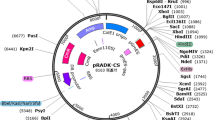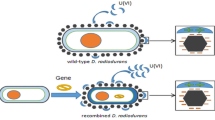Abstract
Deinococcus radiodurans (DR) is highly resistant to ionizing radiation. This study aims to convert dsrA gene into DR to construct radiation-resistant genetically engineered bacteria (Deino-dsrA) with high reducibility, so as to enhance the reducing and enrichment ability of DR. Methods: the recombinant vector pRADK-dsrA was extracted and transformed into DR. 1. Radiation resistant gene engineering bacteria containing dsrA gene were constructed successfully. 2. In the most favorable conditions,contributing to approximately 92.45% U (VI) was removed. 3. Autioxidant enzyme activities in Deino-dsrA is higher than in Deino-pRADK, excepting the content of malondialdehyde. The uranium enrichment ability of the Deino-dsrA is better than the wild DR, and dsrA gene can increase its antioxidation capability by increasing the activity of oxidase.























Similar content being viewed by others
References
Xi J, Wang J, Liang B (2019) A review of nuclear energy research. Shandong Chem 48(21):51–52
Guo H et al (2018) High radionuclides in groundwater of an inland basin from Northwest China: origin and fate. Acs Earth Space Chem 2(11):1137–1144
Wang QY (2000) Radioactive hazards of uranium mines and their prevention and control. China Mining Magazine 9(1):81–83
Loiseau T, Mihalcea I, Henry N, Volkringer C (2014) The crystal chemistry of uranium carboxylates. Coord Chem Rev 266/267(May):69–109
Zhao C, Wang B, Wang SP, Huang YM, Lei ZW (2020) Removal of uranium from a uranium mine wastewater by ion-exchange resin adsorption. Min Metall 29(06):83–86
Zhang YL, Wang M, Zhang Y, Guo F (2021) Experimental study on the reductive treatment of uranium - containing wastewater by membrane distillatio. Technol Water Treat 1–5
Guo M (2020) Progress in the treatment of uranium-containing wastewater. Technol Innov Appl 326(34):125–126
Kulkarni S, Ballal A, Apte SK (2013) Bioprecipitation of uranium from alkaline waste solutions using recombinant Deinococcus radiodurans. J Hazard Mater 262:853–861
Gadd GM, Pan X (2016) Biomineralization, bioremediation and biorecovery of toxic metals and radionuclides. Geomicrobiol J 33(3–4):175–178
Li YP, Zhong J (2002) Cloning and sequencing of a dsrA gene encoding dissimilatory sulfite reductase in a sulfate reducing bacteria consortium (SRB III). J Fudan Univ Nat Sci 41(06):674–678
Zhao YG, Ren NQ, Wang AJ, Shang HX (2006) Characterization of efficiency- enhancing bacterium for sulfate wastewater treatment and structure analysis of dissimilatory sulfite reductase gene. CIESC J 57:2401–2406
Chou FI, Tan ST (1990) Manganese(II) induces cell division and increases in superoxide dismutase and catalase activities in an aging deinococcal culture. J Bacteriol 172(4):2029–2035
Cong Y (2013) Effect of antioxident capacity on irradiated Pichia pastoris by the transfection of Deinococcus radiodurans pprl gene. J Radiat Res Radiat Process 31(04):33–36
Luo J, Zhu QQ, Li SS (2021) Construction of Deino-flr-2 radiation-tolerant genetically engineered strain containing flr-2 fluoride-tolerant gene and its enrichment behavior for U(VI). J Radioanal Nucl Chem 328(3):1265–1278
Guo ZZ (2018) (2018) Study of Cu2+and Cr6+sorption by Deinococcus radiodurans. Chem Res Appl 30(03):327–332
Chiaki S (2021) Analysis of protein denaturation, aggregation and post-translational modification by agarose native gel electrophoresis. Int J Biol Macromol 172:589–596
Asma EO (2021) Chromium (III) biosorption of deinococcus radiodurans and its vitreoscilla haemoglobin (vgb) gene-transferred recombinants. J Pharm Pharmacol 9:140–148
Guo ZZ (2018) Adsorption of copper, chromium and uranylions by Deinococcus radiodurans and construction of genetic engineering vector. University of South China
Liang SJ (2010) Study on Construction and U(VI) Bioaccumulation performance of recombinant D. radiodurans phoN. University of South China
Du L (2015) Determination of micro uranium by arsenazo spectrophotometry. Metall Anal 35(001):68–71
Li K (2020) Research progress on membrane separation technology for the utilization of copper- contaminating wastewater. China Resour Compr Utili 38(07):119–121
Illiyas M (2020) Understanding the survival mechanisms of Deinococcus radiodurans against oxidative stress by targeting thioredoxin reductase redox system. Arch Microbiol 202(9)
Shang D (2021) Dynamic polyphosphate metabolism coordinating with manganese ions defends against oxidative stress in the extreme bacterium deinococcus radiodurans. Appl Environ Microbiol 87(7):e02785-e2820
Gao L (2020) Comparative proteomics analysis reveals new features of the oxidative stress response in the polyextremophilic bacterium deinococcus radiodurans. Microorganisms 8(3):451
Pavel K (2021) Measuring the concentration of protein nanoparticles synthesized by desolvation method: comparison of bradford assay, BCA assay, hydrolysis/UV spectroscopy and gravimetric analysis. Int J Pharm 599:120422
Huang LJ, Yi FC (2011) Red beds of chemical species of uranium and Eh-pH phase diagram. J Southwest Univ Sci Technol 26(01):1–5
Yang J (2015) Biosorption of radionuclide uranium by Deinococcus radiodurans. Spectrosc Spectr Anal 35(004):1010–1014
Wang M (2011) Effect of pH and ionic strength on U(IV) sorption to oxidized multiwalled carbon nanotubes. J Radioanal Nucl Chem 288(3):895–901
Yang S (2017) Ion-imprinted mesoporous silica for selective removal of uranium from highly acidic and radioactive effluent. ACS Appl Mater Interfaces 9(34):29337–29344
Sun Y (2015) Adsorption and desorption of U(VI) on functionalized graphene oxides: a combined experimental and theoretical study. Environ Sci Technol 49(7):4255–4262
Fan LF, Xie SB, Liu YJ (2016) Adsorption of U(VI) containing wastewater by E. coli with phytic acid. Chin J Environ Eng 8:4167–4171
Xiao FZ (2016) Adsorption behavior and mechanism of uranium (VI) on Deinococcus radiodurans immobilized functionalization magnetic carrier. Chin J Nonferrous Met
Saha D (2016) Non-competitive and competitive adsorption of heavy metals in sulfur-functionalized ordered mesoporous carbon. ACS Appl Mater Interfaces 8(49):34132
Mckay Y (1999) Pseudo-second order model for sorption processes. Process Biochem 34(5):451–465
Yang C (1998) Statistical mechanical study on the freundlich isotherm equation. J Colloid Interface Sci 208(2):379–387
Acknowledgements
This work was financially supported by the Nature Science Foundation of Hunan Province in 2020(2020JJ6050、2020JJ4077).
Author information
Authors and Affiliations
Corresponding authors
Ethics declarations
Conflict of interest
The authors declare no conflict of interest.
Additional information
Publisher's Note
Springer Nature remains neutral with regard to jurisdictional claims in published maps and institutional affiliations.
Rights and permissions
About this article
Cite this article
Cheng, C., Xie, J., Zhu, Q. et al. The reduction effect and mechanism of Deinococcus radiodurans transformed dsrA gene to uranyl ions. J Radioanal Nucl Chem 330, 1075–1090 (2021). https://doi.org/10.1007/s10967-021-08038-7
Received:
Accepted:
Published:
Issue Date:
DOI: https://doi.org/10.1007/s10967-021-08038-7




